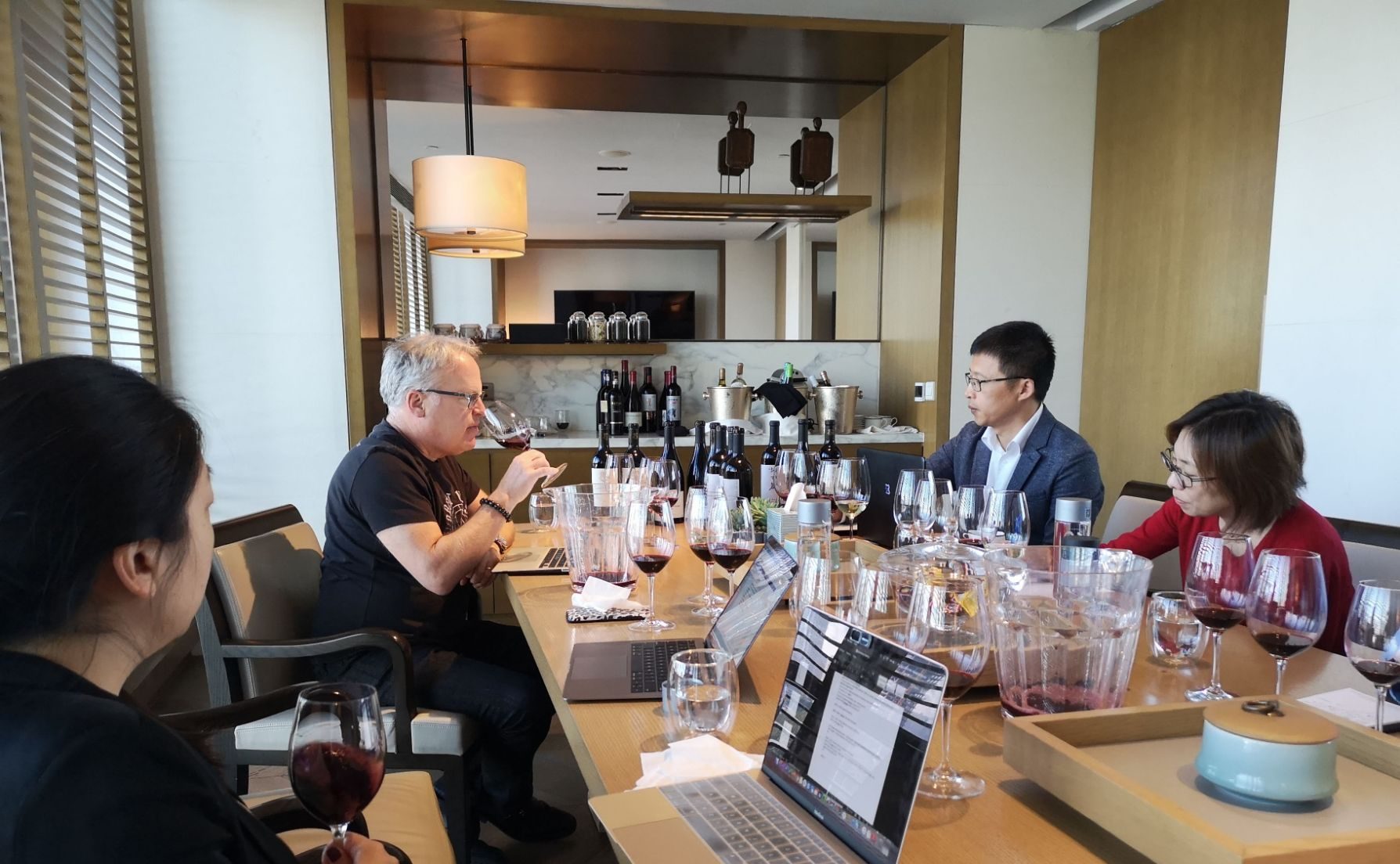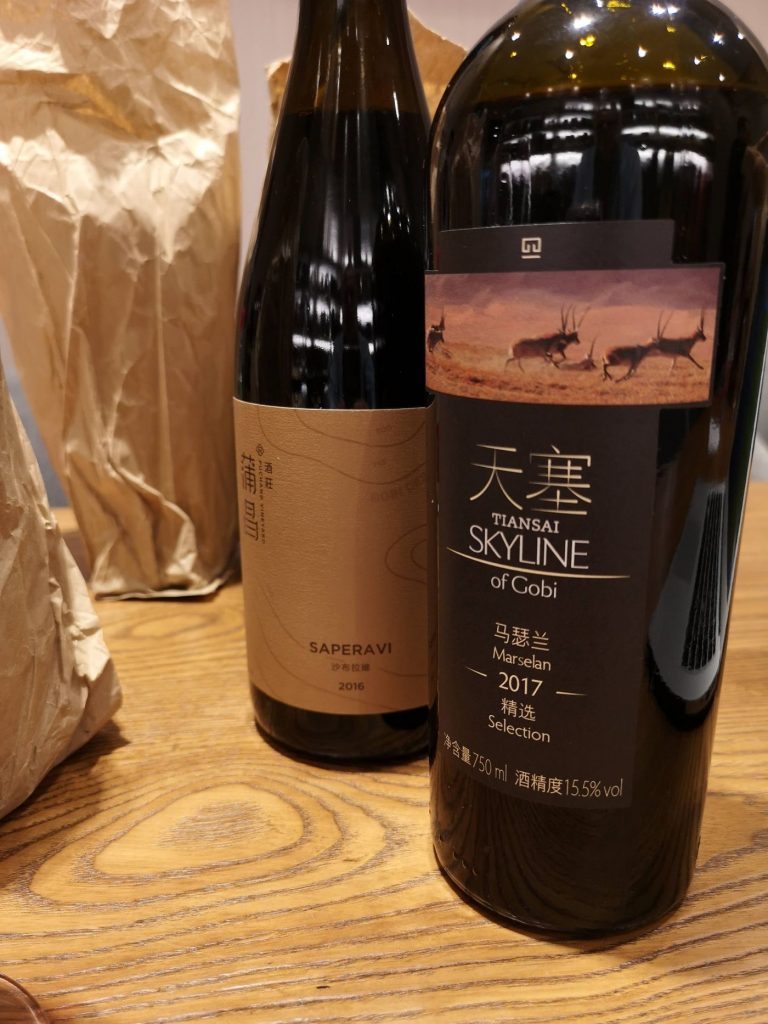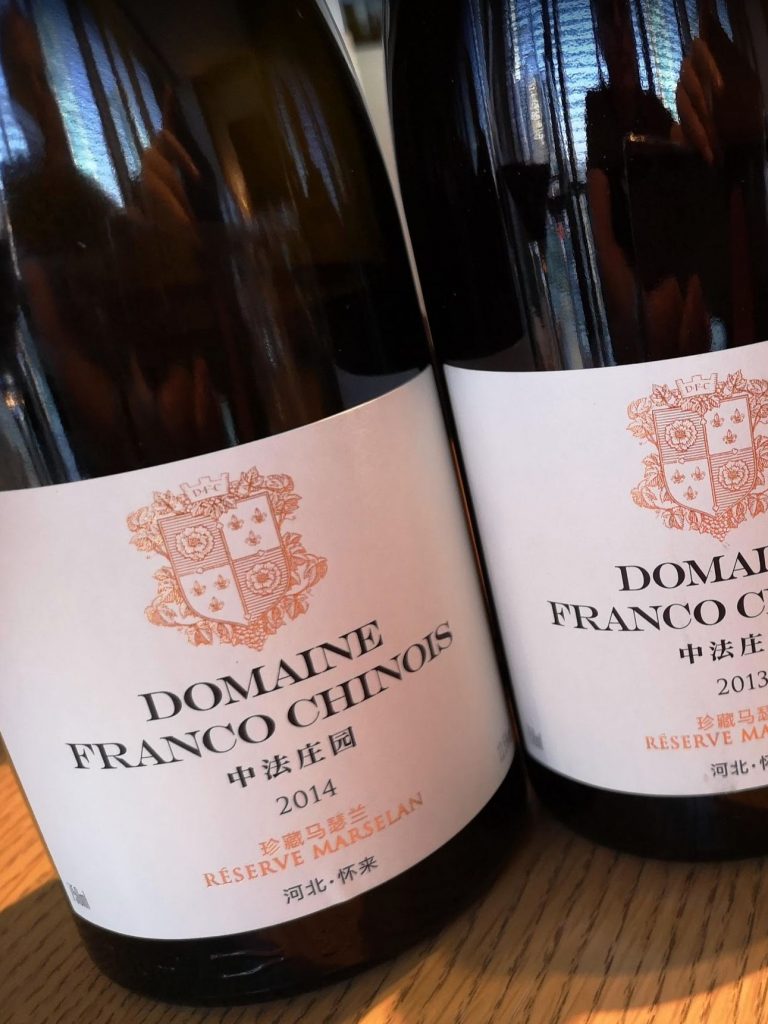Small China tasting reveals big progress from top producers

James tastes a few of the 140 wines on the China tasting trip.
Despite the huge potential for wine consumption in China, where does the country’s wine production stand now?
Last year we tasted 140 Chinese wines – not a huge number, but the result was worth noting: 77 samples (55 percent) received scores of 90 points or more. Apart from the more established names such as Helan Qingxue, Grace Vineyard and Silver Heights, we also found newcomers on the list who are making wines of excellent quality.
Long Dai for example, opened its winery in 2019 after a full 10 full years of construction and vineyard preparation. The winery on the Shandong Peninsula is owned by the Rothschild family of Chateau Lafite-Rothschild, and is now arguably the best winery in China. We visited Long Dai during its opening, and it is exciting to hear that the wines will be marketed primarily to Chinese consumers.
Its refined, velvety Long Dai Qiushan Valley 2017 (94 Points), a blend of cabernet sauvignon, marselan and cabernet franc, is a fine Chinese expression with Bordeaux breeding, mingling juicy freshness, polished tannins and a linear texture. “It took years to understand our vineyards and make wine that was to our quality standards,” said Olivier Trégoat, technical director of Domaines Barons de Rothschild (Lafite). “Each year we learn more and our vineyards get older. We should make better wines in the future.”
Other big French names drawn to China include Pernod Ricard, which has found a home in Ningxia with its Helan Mountain winery, and LVMH, who launched the successful Ao Yun label in the Yunnan region. The Ao Yun Shangri-La 2015 (95 points) is a glorious example of what’s possible here, showing fruit, spices and such fine tannins.
In addition, respected winemakers and consultants like Jean-Claude Berrouet, formerly of Chateau Petrus, have also played a role in shaping the industry. So there is no doubt of the potential here, for winemaking as well as wine consumption, and the huge, vast scale of the country means there is a wide spectrum of terroirs.
Ningxia is the hub of many modern Chinese wineries. The autonomous region’s name appears on many Chinese wines. In extremely cold places such as Liaoning and Jilin in the north, ice wine is very popular, while milder climates are found in places like the Shandong Peninsula. Dry regions like Ningxia and Xinjiang are known for their intense sunshine and large diurnal temperature differences, but the severe weather in the winter can also cause growers to bury their vines in the soil to prevent frost damage. This is an extra labor cost for many producers in Hebei, a region near Beijing that also has to deal with the cool monsoon rainfall in the summer.
Read more about Long Dai: A new beginning for Chinese wine and Shandong
Read more about Ao Yun: China’s wine Shangri-La
- DBR Technical Director Olivier Tregoat and JamesSuckling.com Publisher Meaghan Qian-Fu Becker discuss rootstocks in one of the Long Dai vineyards.
- The 2017 Long Dai is an excellent debut from the label.
- Serenity is a word that comes to mind when looking at the grounds of the Long Dai winery in Penglai.
Top China wines
As well as the Ao Yun and Long Dai wines, the other most notable wine in our list was the Domaine Franco-Chinois Marselan Reserve Huailai 2014 (94 Points) from Hebei, leading the marselan category with a rich, flavorful black fruit profile complemented by a spicy, tarry character in the palate.
Canaan Winery, the sister winery of Domaine Franco-Chinois, delivered an outstanding cabernet sauvignon-driven blend from Hebei Province. The Canaan Winery Shi Bai Pian Reserve Cabernet Sauvignon Huailai 2014 showed exceptional persistence throughout our tasting with remarkable intensity, depth and seriousness, while Canaan Winery Shi Bai Pian Reserve Cabernet Sauvignon Huailai 2017 unfolded rich, generous flavors on its full-bodied palate, but without being hefty. Both received 93 points.
Chateau Nine Peaks Qi Chardonnay Tsingdao 2016 (93 points) from Shandong Province tops the chardonnay league with its creamy and refreshing style. The full, luscious ice wine Changyu Golden Icewine Valley Liaoning 2017 (93 points) from the far north of China added diversity to our list, with immense concentration, tons of pure dried fruit and mouthwatering acidity.
Xinjiang also showed well with two 92-point wines, including a saperavi. Puchang Vineyard and Tiansai Skyline of Gobi are two producers to keep an eye on. Chateau Zhongfei is also worth noting for syrah/shiraz and possibly marselan as well.
While we did not taste many wines from Yunnan this time, the LVMH property Ao Yun has already made a name for itself, and their 2015 vintage is a must-try. Grace Vineyard’s Tasya’s Reserve 2016, made from marselan and rated 91 points, also put Shanxi on the map during our tasting.
- James meets Ole wine cellar, one of China’s biggest food and drink retailers.
- A tasting table sits amid barrels in the Long Ting winery.
- The cabernet blends from Ninxia were all excellent.
Ningxia investment pays off
The top scorers from the more renowned Ningxia region did not disappoint either. Four wines received 93-point scores and all are cabernet blends. The local government and producers have spent hundreds of thousands of dollars promoting their region with winemaking competitions, consulting winemakers and Masters of Wines, and other marketing campaigns. However we found many of the wines over ripe and over extracted. We question how it became known as the best wine region in China – in our view it is too early to call any region the best just yet.
Lingering Clouds Red Beard Cabernet Sauvignon Ningxia 2017 (93 points) was an eye-catcher during our tasting. This boutique, “garage” wine scrupulously made in small quantities by independent winemaker Liu Jianjun showed precision and poise, with bright acidity and fine tannins setting a good example for wineries looking for restraint, complexity and drinkability. Helan Qingxue Vineyard Jiabeilan Reserve Ningxia 2014 (93 points) is a good example of sophisticated winemaking with a style almost like a fine, medium-bodied Bordeaux. Complexity will come with age, punctuating the cassis, cedar and tobacco leaves characters. Kanaan Winery Black Beauty Ningxia 2012 (93 points), not to be confused with Canaan Winery from Huailai of Hebei, is a rich and complex wine made in a small quantity that combines freshness and generosity. Chateau Mihope Reserve Dry Red Ningxia 2017 (93 Points) takes a bolder approach with a dark, tarry nose, immense concentration and fruity sweetness on the palate and a fine tannin framework.
Other producers from Ningxia who impressed us included Lilan Winery, Domaine Chengcheng, Jade Vineyard, Silver Heights and Holan-Soul, Chateau Chanson and Changyu Moser.
- Great Wall is one of China’s best known producers, and its marselan wines are among its best.
- Tiansai is one of the producers from Xinjiang to watch.
- The Domaine Franco Chinois 2014 Reserve from Hebei scored an excellent 94 points.
Where next for Chinese wine?
Having tasted some 140 Chinese wines, it’s clear that the quality of Chinese wine has improved tremendously over the last decade. We also suspect that there are still many poor quality wines being made in bulk – we simply were fortunate enough not to encounter them.
We also realize that China’s laws and regulations concerning winemaking are still elastic and though we believe all the samples that we received were authentic, there is still a lot of room for fraud. We know that Chilean and Australian wines, among others, are used to improve local table wines, for example.
Some wines were also overly sweet or sweet-sour (see our tasting notes), and this is especially the case in Xinjiang and Ningxia. High-octane wines with low acidity are also being made everywhere, at the cost of balance and finesse. But one thing is very clear: winemakers are realizing that oak barrels do not automatically translate into quality. There are still lots of oaky wines, but compared with the last 10 years, winemakers appear to have a deeper understanding of wood.
Zhao Desheng, winemaker of Domaine Franco-Chinois and Canaan Winery of Huailai, told us that many Chinese still hold up against domestic wines. “The image is still not as sound as imported wine,” he said. “When Chinese people think of good wine, imported wines such as French wine easily comes first. Boutique wineries still need time to better position themselves in the market and go out for promotion. It’s about time, it’s about willingness and it’s about money. In other words, there is still a long way to go.”
Overall our small tasting of some excellent Chinese wines suggests a bright future. We were pleased to see that some of the wines made in China today are able to live up to our expectations. At the same time it will be a while before wineries find the consistency required of a global wine player. Consumers will also need time to reevaluate the reputation of many of these domestic wines.
For journalists and critics like us, it is time to start to consider Chinese wine in a new light. It is a serious player in the wine industry now, not just in terms of consumption but also in terms of production.
– James Suckling, CEO & editor, and Zekun Shuai, associate editor








